The science of preserving art Inspire article
As Head Conservator at the National Trust, Katy Lithgow’s education turned her into ‘more an arts person’ than a scientist – but her work has shown how the two can be inextricably linked. Vienna Leigh finds out how.
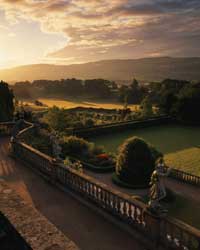
terraces at dawn,
Image courtesy of the National
Trust Photo Library / Andrew Butler
If you’ve ever holidayed in Britain, you’ll know that the countryside is awash with historic properties and their gardens, areas of natural beauty, castles, ruins, forts and nature reserves. Whether it’s a house with a literary or historical connection – Hardy’s Cottage, Wordsworth House, or Cliveden, once the glittering hub of high society – or a World Heritage Site – the Giant’s Causeway, the Avebury stone circle or Hadrian’s Wall – there’s something for everyone, and much of it owes its continued existence to the National Trust.
Keeping these examples of national heritage in good condition – as well as open to the public – not only requires the help of the Trust’s 52 000 volunteers, but also relies on the expertise of a team of conservation specialists behind the scenes, including wardens, gardeners and curators.
Head Conservator Katy Lithgow is one such expert. Originally an art historian, Katy is now responsible for the preventive and remedial conservation of collections and historic interiors in the National Trust’s houses. Having graduated from Cambridge, her first foray into the field was at London’s Courtauld Institute wall painting conservation. “It seems to me that people stumble across this career path, often through pursuing an interest, in my case by trying to combine a love of painting and drawing with an interest in the history of art and the technology of art production,” she says. “At school it’s hard to get to know about my sort of job – it’s not something on the standard careers list.”
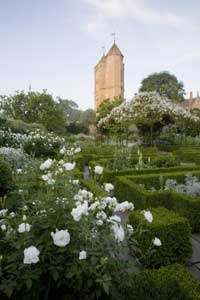
White Garden
Image courtesy of Jonathan Buckley
There’s much more to her job than renovating old paintings. Katy’s working day might include reviewing the installation of solar cells or insulation in a castle’s roof, examining potential acquisitions to determine their conservation needs, providing training to National Trust staff, giving talks at museums or art galleries, or participating in policy meetings. She often works alongside the wider conservation community to identify research needs in cultural heritage, for example by participating in collaborative research promoted by the Science and Heritage programme. “Though I think of myself as more of an arts and humanities person than a group scientist, it’s science that enables us to continue to welcome visitors by preserving our properties for the future,” Katy says. “If we opened houses without taking account of what causes their deterioration, we would risk them being damaged and destroyed. Specifically, we’re concerned with how environmental light, affect objects, materials and structures. or taking part in the UK’s National Heritage Science Strategy steering
“Science helps us in an endless number of ways. After the flooding of the library in the Long Gallery at Blickling Hall (a Jacobean house in Norfolk), we were able to treat the precious contents using our understanding of the way materials behave when they become wet. We use photomicrographs to see how the products of bacteria – called ‘sticky exo-polymers’ – combine with damp and the calcite in dust particles to bind the dust onto historic surfaces. This led to the development of a method of monitoring the production of dust by visitors, which tells us how to manage the rate of cleaning to prevent objects becoming irreversibly soiled. We use sensors to tell us whether the amount of light to which a surface has been exposed is too great, and that helps us control light for the benefit of visitors and our collections; we design conservation heating systems using relative humidity and temperature data. We even used science to determine why John Hungerford Pollen’s paintings on the frieze of the Long Gallery at Blickling Hall look so worn (scientific analysis showed he had a poor painting technique!).”
So, as a self-professed ‘arts person’, how does Katy take to the scientific side of her work? “I was always aware through my studies of Italian Renaissance painting how close the arts and sciences really are. Art is and always has been heavily influenced by scientific theory and discoveries – the science of colour, pigments, perspective, and so on – and scientific data is needed to support arts research, for example to establish the authenticity of a work of art. Similarly, science can be artistic, too – during a moment of inspiration, for example – and humanities skills such as writing and giving presentations are required to communicate science. In addition, both arts and sciences rely on evidence, which is tested by validating hypotheses. In both cases, these hypotheses have to hold in relation to different sorts of research.
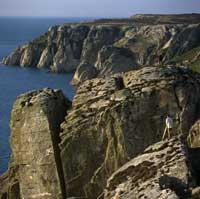
Lundy Island, with an archaeologist
carrying out a
measured survey in the foreground
Image courtesy of the National
Trust Photo Library / Joe Cornish
“At school, though, science and I didn’t get on. I still maintain that it was mere coincidence that led me to choose boiling flasks with hairline cracks that exploded and etched the wooden worktops with bubbling black viscous treacle, but my teacher seemed to think that my main aim in life was to subvert all her lessons. It was only during my training as a wall painting conservator that science really came back into my life in an applied sense.
“Nowadays, a scientific background is a tremendous asset to have in conservation. There are specific courses available for people who come from the humanities, such as the Chemistry for Conservators correspondence course offered by International Academic Projects Ltd.”
The National Trust carries out scientific research within projects with other heritage and educational institutions, gaining funding through grants and initiatives such as the EU-funded research project Climate for Culture year.
“It may not occur to our visitors, but climate change is having a huge effect on the work of the National Trust,” Katy says. “It’s the challenge of our times, and it affects everything. Flooding at Calke Abbey (a Baroque mansion in Derbyshire) and Coughton Court (a Tudor family seat in Warwickshire) in the summer of 2007 was the result of severe and unseasonal rainfall attributed to climate change. The Engineering Historic Futures project Sciences Research Council) Climates programme, is another scientific research project which looked at adapting historic environments to the effects of climate change, and it used the flooding at Blickling Hall as a case study.
“In historic houses we also see climate change in the form of increased insect pest activity by furniture beetle and moths; there’s also more mould. All our work is set in the context of trying to save energy and reduce the carbon footprint to help mitigate climate change, as well as adapting to its impacts.”
Science aside, though, it’s the aesthetics of her job that get Katy out of bed in the morning. “Solitary moments with achingly beautiful views of houses and landscapes… there’s nothing like it,” she smiles.
Case study: James II’s bed
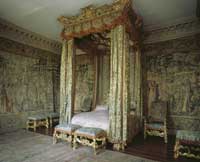
cleaned fragments of the silk
velvet curtains
Image courtesy of the National
Trust / Textile Conservation Studio
“As head conservator, I’m responsible for identifying the most urgent conservation work needed to be done on National Trust collections. The priority of the work depends on the rate of change in condition, the quality of the display environment, and how the project would fit into the overall plans for presenting and developing the property.
Currently, the top national priority is the James II bed at Knole – one of the great treasure houses of England and the birthplace of author and poet Vita Sackville- West – near Sevenoaks in Kent. Research has shown that the bed is likely to have been commissioned by King James II of England, Scotland and Ireland in around 1688, shortly before he was chased out of the country in the Glorious Revolution of 1689 that saw the installation of William and Mary as joint Protestant monarchs. The Lord Chamberlain of the time, Thomas Sackville, 6th monogrammed bed – now an undesirable symbol of a defunct regime – and moved it to Knole in 1701.
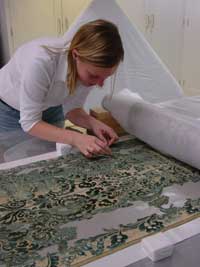
Image courtesy of the National Trust
Photo Library / Andreas von Einsiedel
When the National Trust’s staff at Knole noticed that the bed’s curtains were ripping under their own weight, our textile conservation adviser, Ksynia Marko, investigated the options for treatment. Analysis showed that the hangings are made of a silk velvet which is extremely sensitive to damage from exposure to light. Over time, the oxidation of the silk fibres has caused them to shatter and collapse, aided by the forces of gravity.
There have been at least three attempts to treat the hangings. During the most recent endeavour, which was as long ago as 1959, a natural latex adhesive called ‘gutta- percha’ was used to glue the fragments of silk velvet to new linings – but 50 years on, the glue has chemically altered. It’s now brittle and dark, staining the original textile Earl of Dorset, acquired the and no longer able to support its weight.
We removed the curtains from display to identify the solvents and method of treatment needed to remove the old adhesive, and cleaned the silk velvet and reattached it to new supporting fabric. In the meantime, we’ve started to raise the £850 000 needed to fund the conservation of the rest of the bed, its hangings and associated furniture, and redisplay.”
Web References
- For more information about the National Trust, see: www.nationaltrust.org.uk
- For more information about the Courtauld Institute of Art, see: www.courtauld.ac.uk
- The Science and Heritage programme supports and funds interdisciplinary research. To learn more, see: www.heritagescience.ac.uk
- National Heritage Science Strategy steering group is responsible for developing
- For more information about International Academic Projects Ltd, which promotes education, training and research into conservation, archaeology and anthropology, see: www.academicprojects.co.uk
- For more information about the Engineering Historic Futures project, see:www.ucl.ac.uk/sustainableheritage/historic_futures.htm
- To find out more about the UK’s Engineering and Physical Sciences Research Council, see: www.epsrc.ac.uk
Resources
- If you’re looking for activities to link arts and science in the classroom, you might like the following Science in School articles:
- Farusi G (2006) Teaching science and humanities: an interdisciplinary approach.
- Farusi G (2007) Monastic ink: linking chemistry and history.
Review
The article provides general information on what a career in conservation of sites and objects of artistic and historical significance is all about, and how science is involved in such efforts. The many examples included are valuable in directing discussions in the science classroom focusing on how various environmental influences could affect objects, materials and structures in ways that would lead to their deterioration, and how global climate change is negatively affecting our cultural heritage.The text is most suitable to be used in science, history and arts classes to show how these three areas of research can be combined to achieve the conservation of historic sites and artefacts. In school, interdisciplinary studies could be organised, with history and arts groups specifying specific environmental situations that threaten to destroy sites and artefacts of cultural value and science groups trying to find the solutions.
Michalis Hadjimarcou, Cyprus





